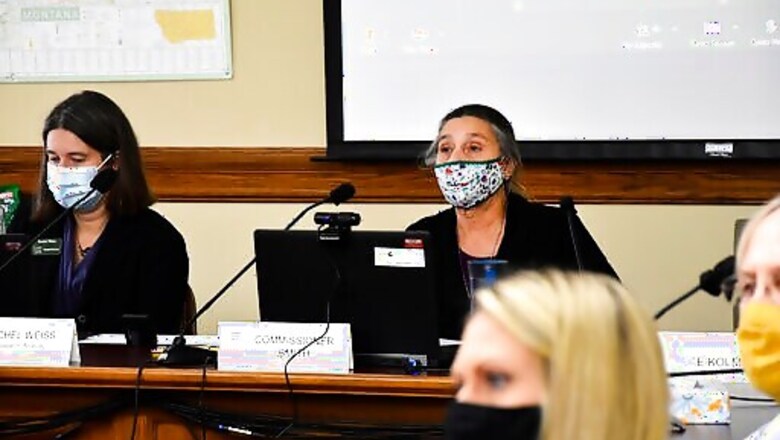
views
HELENA, Mont.: A new map dividing Montana into two congressional districts for the first time in decades was finalized Tuesday, triggering disappointment from Democrats who hoped to craft a different western district that would give them a better chance of winning in an increasingly Republican-dominated state.
The 2020 census gave Montana a second congressional district for the first time in 30 years, spurring a redistricting process that has included debate about the changing nature of the state. Booming cities such as Bozeman and Missoula in western Montana provide a contrast to the stagnating agricultural communities in the prairie region that covers the eastern half of the state.
In a bitterly disputed process that played out over several months, Democrats managed to keep liberal college towns Missoula and Bozeman in the western district, but lost the state capital of Helena to the solidly red eastern district.
The final map was proposed by Republicans on the bipartisan redistricting commission and selected by nonpartisan chair Maylinn Smith after Republicans and Democrats could not come to an agreement on how to draw a second congressional district.
Defending her choice, Smith said she believed the right Democratic candidate could win in the western district under the selected map crafted by Republicans basing that assessment on past voting data that showed that statewide congressional Democratic candidates would have won 25% of the time in the western district. That data is drawn from voting records for the state’s two U.S. Senate seats and the lone U.S. House seat between 2012 and 2020.
But political scientist Jeremy Johnson said that politics in Montana and across the country are shifting, and that more recent elections, including the 2020 election when Trump won the state by 16 points and all statewide Democratic candidates were routed, are a more accurate representation of whats to come in the next decade.
The Trump vote is probably a better predictor for future partisanship in Montana, than looking at some of these earlier elections when ticket splitting is more common, said Johnson, a political science professor at Carroll College in Helena. Weve seen in Montana and across the United States that ticket splitting is much less common and theres a lot more straight ticket voting.”
Johnson said he was surprised by Smiths decision to favor the map put forward by Republicans over the one proposed by Democrats, which would have kept Democrat-leaning Helena in a western district and carved out conservative Kalispell to the east. That proposal would have created a more competitive district in the west that favored neither Democrats nor Republicans and would have forced candidates on both sides of the aisle to campaign more vigorously to win moderates and centrists in order to secure a victory.
Dan Stusek, a Republican who was one of five members on the redistricting commission, said he was pleasantly surprised that Smith chose a map he proposed along with fellow Republican commissioner Jeff Essmann, a former chair of the state Republican Party. Stusek, who has worked for Republican U.S. Sen. Steve Daines, agreed with Smith that a Democrat could still win in the western district, which includes fast growing towns Bozeman, Missoula and Kalispell. All three are quickly filling with craft beer drinkers, remote workers and California transplants, but while the first two cities favor Democrats, the latter is solidly Republican.
Unlike Johnson, Stusek believes that the 2020 election result was an outlier, rather than a harbinger for what’s to come. The coming decade, he says, will bring increased competition between Democrats and Republicans in western Montana driven by the growing population of liberal towns.
Itll be a dogfight from here on out, he said. I dont think were in an alternate universe based on 2020.
The effects of the new district lines will play out next year. The race for the new western U.S. House district already has four Democratic candidates and three Republicans, with a primary to be held in June 2022.
The Democratic field includes former state lawmaker Tom Winter, state Rep. Laurie Bishop, public health professional Cora Neumann and lawyer Monica Tranel.
Bishop is the only candidate whose home in Livingston 25 miles (40 kilometers) east of Bozeman is now officially outside the boundaries of the district in which she is running. She was quick to express her disappointment in the new map, saying the commission played politics by separating clear communities of interest and failing to take competitiveness into account in creating this district.”
The Republican field includes pastor Mary Todd, former state lawmaker Al Olszewski and former U.S. Secretary of Interior Ryan Zinke, who leads the field in fundraising by a wide margin, according to campaign reports released last month.
Johnson said that in order for a Democrat to prevail in the western district, it has to be someone who comes across as authentic and somehow connects with Montanans.”
Kendra Miller, a Democrat on the redistricting commission who fought against the Republican-proposed map, said the new district simply isn’t fair to Democrats.
The idea that Democrats have to come up with some sort of unicorn candidate … and the Republicans can run essentially an extremist and still win the seat that’s not a competitive district in my mind,” Miller said.
___
Iris Samuels is a corps member for the Associated Press/Report for America Statehouse News Initiative. Report for America is a nonprofit national service program that places journalists in local newsrooms to report on undercovered issues.
Disclaimer: This post has been auto-published from an agency feed without any modifications to the text and has not been reviewed by an editor
Read all the Latest News here




















Comments
0 comment